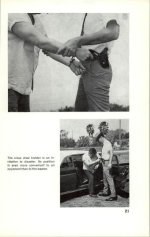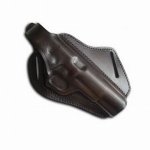I like cross draw carry. It takes a different training regimen than strong side carry, but train for it you can.
Bill Jordan didn’t like cross draw, and in his time for good reason. I was on an “acquaintance” basis with Bill, having chatted for a while with him a couple of times. He was a great person, friendly, very skilled and knowledgeable as a lawman and shooter, and I had/have great respect for him. Attached below is the page from “No Second Place Winner” (from an open source, and free site) that has his cross draw photos and comment:
1. His information on this is dated though. In Bill’s days, handcuffing a prisoner from the front, placing a prisoner in the front seat, and facing nose to nose with said prisoner was not uncommon. Since I first went to a reserve academy and in the many years since, I have never handcuffed a prisoner from the front, placed a prisoner in the front seat, or went nose to nose with such a prisoner; and I’ve never seen it done by another officer because we aren’t trained to do it that way- it’s not considered the safest way to handcuff or transport a prisoner.
2. I find cross draw easier to defend from a snatch attempt. I’ve had several trainings on defending a strong side carried gun (butt of gun best presented to someone behind me) and I’ve taken to training on defending a cross draw carried gun (butt of gun best presented to someone in front of me). I’ve discovered that with my head, arms and hands, legs, knees and feet designed to best address a threat from the front of me, the cross draw carry is easier for me to protect. I have my eyes, forehead, teeth, a hand, plus a knee or a foot to counter attack the threat all while the other hand is clamping down on my handgun; try doing all of that with someone behind you.
3. I find cross draw carry easier to draw from using either hand. A couple times in the past my departments firearms training included a required “your gun arm is injured or engaged; draw your handgun from the holster using your support hand”. Let me tell you something, especially from a level two or level three security holster, this is anywhere from darn difficult to darn near impossible to do. Cross draw is a piece of cake in comparison.
4. With the correct training, drawing from cross draw is no more likely to cause me to sweep a part of my body or another person than a strong side draw. The basic draw is: I lift my left hand up to just above my left shoulder as my right hand reaches across for my holstered handgun. My right hand lifts the gun out of the holster, and then pushes the muzzle of the gun down and out forward (not out to the side). As the gun is leveling toward the threat/target, my forearm is rotated at the elbow to bring the sights up to their proper position. My left hand has pushed out to meet up with and support my right hand. Since my left arm is above the right hands movements, no part of my body is swept. Since the muzzle of the gun is not swept out to the side, no non-threats/targets are swept. This is faster when demonstrated than when told.
It’s all about training.






